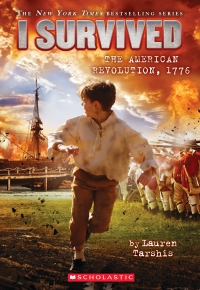I Survived: The American Revolution, 1776 
Tarshis, Lauren. I Survived: The American Revolution, 1776. New York: Scholastic Press, 2017.
Lexile: 660 Recommended for: Grades 3-5
Summary: This is a historical fiction novel about an 11-year-old boy named Nathaniel Fox who never would've believed his life was real to find himself in the middle of a blood-soaked battlefield- fighting for his life. He was being worked to the bo ne by his cruel uncle and finally had enough so decided to flee from home. He finds himself right in the middle of the Revolutionary War. He ends up in New York City only to be involved in one of the biggest battles of history.
Activity: Fact Checking The American Revolution: Did the author portray history accurately?
Students in a 5th grade class will use this book to compare details from the book to factual information of what really happened in the Revolutionary War. They will read and identify examples and details from the text, and use digital resources to fact check their answers. Then they will draw conclusions on whether or not the author was accurate on the portrayal of history and use details to support their claims.
Here is the note taking sheet for identifying details from novel and fact checking through research.
Lesson Outcome: Students will read this historical fiction novel and use details from the text and fact checking through research to conclude whether or not the author was accurate in portraying history.
Objectives/Assessments:
Students will identify three details from the story about the Revolutionary War of 1776, and research in order to fact check to determine of the author was accurate in portraying events. (Cognitive)
Students will draw conclusions from their research on whether or not this book is an accurate portrayal of the real Revolutionary War of 1776. They will present their findings and debate their claims with peers. (Psychomotor, Affective)
Assessment:
Teacher observation of student discussion debates
Standards:
Information Literacy Continuum:
5.6 Uses various note taking strategies (e.g., outlining, underlining, bulleted lists, highlighting, graphic organizers).
5.3 Selects and uses multiple appropriate print, nonprint, electronic, and human sources to answer questions.
Common Core Standards:
Key Ideas and Details:CCSS.ELA-LITERACY.RL.5.1
Quote accurately from a text when explaining what the text says explicitly and when drawing inferences from the text.
AASL Standards:
1.1.7 Make sense of information gathered from diverse sources by identifying misconceptions, main and supporting ideas, conflicting information, and point of view or bias.
Work Cited:
Scholastic.com. Analyzing the Authors Use of Historical Facts- Graphic Organizer. Retrieved on November 1st, 2017 from https://www.scholastic.com/content/dam/teachers/lesson-plans/migrated-featured-files/i-survived-historical-facts.pdf
No comments:
Post a Comment